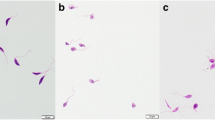Abstract
Tubercidin (TUB) is an adenosine analog with potent antiparasite action, unfortunately associated with severe host toxicity. Prevention of TUB toxicity can be reached associating nitrobenzylthioinosine (NBMPR), an inhibitor of the purine nucleoside transport, specifically target to the mammal cells. It was demonstrated that this nucleoside transport inhibitor has no significant effect in the in vitro uptake of TUB by Schistosoma mansoni and Trypanosoma gambiense. Seeking to evaluate if the association of these compounds is also effective against leishmania, we analyzed the TUB–NBMPR combined treatment in in vitro cultures of promastigote forms of Leishmania (L.) amazonensis, Leishmania (L.) chagasi, Leishmania (L.) major, and Leishmania (V.) braziliensis as well as in cultures of amastigote forms of L. (L.) amazonensis, mice macrophages infected with L. (L.) amazonensis, and in vivo tests in BALB/c mice infected with L. (L.) amazonensis. We demonstrated that TUB–NBMPR combined treatment can be effective against leishmania cells protecting mammalian cells from TUB toxicity.




Similar content being viewed by others
References
Barbieri CL, Giorgio S, Merjan AJ, Figueiredo EN (1993) Glycosphingolipid antigens of Leishmania (Leishmania) amazonensis amastigotes identified by use of a monoclonal antibody. Infect Immun 61:2131–2137
Berman JD, Lee LS, Robins RK, Revankar GR (1983) Activity of purine analogs against Leishmania tropica within human macrophages in vitro. Antimicrob Agents Chemother 24:233–236
Croft SL, Coombs GH (2003) Leishmaniasis—current chemotherapy and recent advances in the search for novel drugs. Trends Parasitol 19:502–508
do Socorro SRMS, Mendonca-Filho RR, Bizzo HR, de Almeida Rodrigues I, Soares RM, Souto-Padron T et al (2003) Antileishmanial activity of a linalool-rich essential oil from Croton cajucara. Antimicrob Agents Chemother 47:1895–1901
el Kouni MH (1991) Efficacy of combination therapy with tubercidin and nitrobenzylthioinosine 5′-monophosphate against chronic and advanced stages of schistosomiasis. Biochem Pharmacol 41:815–820
el Kouni MH (2003) Potential chemotherapeutic targets in the purine metabolism of parasites. Pharmacol Ther 99:283–309
el Kouni MH, Diop D, Cha S (1983) Combination therapy of schistosomiasis by tubercidin and nitrobenzylthioinosine 5′-monophosphate. Proc Natl Acad Sci U S A 80:6667–6670
el Kouni MH, Messier NJ, Cha S (1987) Treatment of schistosomiasis by purine nucleoside analogues in combination with nucleoside transport inhibitors. Biochem Pharmacol 36:3815–3821
Hammond DJ, Gutteridge WE (1984) Purine and pyrimidine metabolism in the Trypanosomatidae. Mol Biochem Parasitol 13:243–261
Kapler GM, Zhang K, Beverley SM (1990) Nuclease mapping and DNA sequence analysis of transcripts from the dihydrofolate reductase-thymidylate synthase (R) region of Leishmania major. Nucleic Acids Res 18:6399–6408
Kayser O (2000) Nanosuspensions for the formulation of aphidicolin to improve drug targeting effects against leishmania infected macrophages. Int J Pharm 196:253–256
Landfear SM, Ullman B, Carter NS, Sanchez MA (2004) Nucleoside and nucleobase transporters in parasitic protozoa. Eukaryot Cell 3:245–254
Murray HW, Berman JD, Davies CR, Saravia NG (2005) Advances in leishmaniasis. Lancet 366:1561–1577
Ogbunude PO, Ikediobi CO (1982) Effect of nitrobenzylthioinosinate on the toxicity of tubercidin and ethidium against Trypanosoma gambiense. Acta Trop 39:219–224
Ogbunude PO, al-Jaser MH, Baer HP (1991) Leishmania donovani: characteristics of adenosine and inosine transporters in promastigotes of two different strains. Exp Parasitol 73:369–375
Olliaro PL, Bryceson AD (1993) Practical progress and new drugs for changing patterns of leishmaniasis. Parasitol Today 9:323–328
Pereira WK, Lonardoni MV, Grespan R, Caparroz-Assef SM, Cuman RK, Bersani-Amado CA (2005) Immunomodulatory effect of Canova medication on experimental Leishmania amazonensis infection. J Infect 51:157–164
Rittig MG, Bogdan C (2000) Leishmania–host-cell interaction: complexities and alternative views. Parasitol Today 16:292–297
Singh S, Mohapatra DP, Sivakumar R (2000) Successful replacement of fetal calf serum with human urine for in vitro culture of Leishmania donovani. J Commun Dis 32:289–294
World Health Organization/Tropical Disease Research (WHO/TDR) (2008) Strategic direction for research. http://www.who.int/tdr/diseases/leish/direction.htm
Acknowledgements
This work was supported by CNPq (473.121/2004-2), FAPESP (00/10016-1 and 06/04656-4), LIM-48 (FM-USP) and by fellowships from CNPq (P.C.C.), CAPES (J.I.A.), and FAPESP (D.C.C.R.). All procedures in this study are in accordance with the Brazilians laws and complied with the ethical guidelines of the institution for experiments with animals. The in vivo analyses were conducted according to the Guide for the “Care and Use of Laboratory Animals” from the National Academy of Sciences (http://www.nap.edu).
Author information
Authors and Affiliations
Corresponding author
Rights and permissions
About this article
Cite this article
Aoki, J.I., Yamashiro-Kanashiro, E.H., Ramos, D.C.C. et al. Efficacy of the tubercidin antileishmania action associated with an inhibitor of the nucleoside transport. Parasitol Res 104, 223–228 (2009). https://doi.org/10.1007/s00436-008-1177-z
Received:
Accepted:
Published:
Issue Date:
DOI: https://doi.org/10.1007/s00436-008-1177-z



